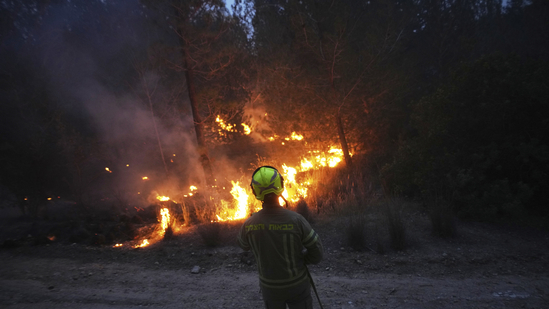The Israel-Gaza Crisis and 2025 Wildfires: A Comprehensive Overview
Introduction
As of May 2025, Israel is simultaneously grappling with a severe environmental disaster in the form of devastating wildfires and an escalating military conflict with Hamas in Gaza. These two crises — one natural and one geopolitical — have dominated headlines and shaped the region’s immediate future. This document provides a comprehensive, fact-based overview of the latest developments, their causes, consequences, and key figures, alongside a deeper look at the broader historical and political context.
Part 1: Israel’s 2025 Wildfires
Overview
On April 30, 2025, catastrophic wildfires broke out in central Israel, particularly between the areas of Eshtaol and Latrun, just west of Jerusalem. These fires quickly spread due to a rare combination of high temperatures, gusty desert winds, and prolonged drought conditions. Experts and Israeli authorities have described these fires as potentially the largest wildfire event in the nation’s history.
Key Facts and Figures
- Location: Primarily central Israel, including areas near Neve Shalom, Highway 3, Canada Park, Mesilat Zion, and Ramat Beit Shemesh.
- Area Burned: Approximately 11,700 dunams (around 2,900 acres) of forests and farmland were destroyed within the first 48 hours.
- Evacuations: Over 9 residential communities evacuated, displacing approximately 14,000 people.
- Casualties: At least 23 individuals treated for smoke inhalation, burns, and related injuries. No direct fatalities reported at the time of writing.
- Infrastructure Impact: Temporary closure of Highway 1, the main Jerusalem-Tel Aviv artery; damage to electric grids and water lines in evacuated zones.
Causes of the Wildfires
- Climate Conditions: Israel’s 2025 spring has seen record-breaking dryness, with less than 30% of average rainfall in the preceding winter months. Combined with soaring temperatures surpassing 35°C (95°F) and strong eastward winds, the environment became a tinderbox.
- Human Activity: Authorities suspect that a combination of accidental human negligence — possibly unattended campfires or discarded cigarettes — and under-maintained firebreaks contributed to the fires’ ignition and spread.
- Environmental Factors: Years of forest mismanagement and increasing temperatures linked to climate change have exacerbated wildfire risks.
Government Response
Prime Minister Benjamin Netanyahu called for international assistance and declared a state of emergency in affected regions. Over 1,000 firefighters, 20 firefighting planes, and hundreds of volunteers were deployed. Countries such as Greece, Cyprus, and France offered support in the form of firefighting aircraft and specialized teams.
Part 2: Israel–Hamas Conflict 2025
Historical Context
The Israeli–Palestinian conflict has been an ongoing struggle since the mid-20th century, rooted in disputes over land, governance, and national identity. Hamas, an Islamist militant group controlling Gaza since 2007, has engaged in repeated military conflicts with Israel over the years. The latest round of hostilities in 2025 marks one of the deadliest phases of the conflict since 2014.
Current Military Situation (May 2025)
Following a breakdown in ceasefire negotiations earlier this year, Israel launched renewed military operations in Gaza. This escalation stems from Israel’s stated goal of pressuring Hamas to release hostages and to degrade its military infrastructure.
Key Facts and Figures
- Duration of Current Escalation: Began February 2025; now entering its 3rd month.
- Palestinian Casualties: Over 52,000 Palestinians reported killed (civilians and combatants combined).
- Israeli Casualties: Approximately 1,100 Israelis killed, mostly due to rocket fire and infiltration attempts.
- Displacement: An estimated 1.4 million Palestinians (around 60% of Gaza’s population) have been displaced internally.
- Airstrikes: Over 5,000 Israeli airstrikes reported targeting Hamas tunnels, command centers, and weapons depots.
Aid and Humanitarian Crisis
A significant point of international concern is the humanitarian blockade on Gaza. Israel has restricted entry of food, water, fuel, and medicine as part of its strategy to weaken Hamas. This has led to severe shortages and a looming famine.
- Aid Trucks Delayed: Over 3,000 aid trucks are currently stranded at border crossings into Gaza.
- Hospitals: Nearly 70% of Gaza’s hospitals have ceased operations due to lack of fuel and medical supplies.
- International Response: The United Nations and humanitarian agencies have called for an immediate humanitarian corridor.
Ceasefire and Negotiation Status
Despite multiple international efforts (led by Egypt, Qatar, and the U.S.), no durable ceasefire has been achieved.
- Israel’s Position: Israel rejected a proposed five-year ceasefire in April 2025, arguing that it would allow Hamas to regroup militarily.
- Hamas’s Position: Hamas demands a full withdrawal of Israeli forces from Gaza and an end to the blockade in exchange for the release of Israeli hostages.
- U.S. Role: The United States has largely supported Israel’s right to self-defense while calling for humanitarian aid facilitation.
Part 3: U.S. Military Aid to Israel
The United States remains Israel’s largest military and diplomatic ally, providing extensive financial and technological support.
Key Figures
- Annual Aid Package: The U.S. provides $3.8 billion annually in military aid to Israel, under a 10-year Memorandum of Understanding signed in 2016.
- Recent Additional Aid: In March 2025, an expedited $4 billion package was authorized, supplying missile defense systems, precision-guided munitions, and armored vehicles.
- Proposed Arms Sale: An $8 billion arms deal (still pending congressional approval) would supply additional Iron Dome interceptors, artillery shells, and advanced fighter aircraft munitions.
Part 4: Broader Impacts and Geopolitical Implications
Regional Stability
- Lebanon and Hezbollah: Sporadic clashes along Israel’s northern border with Hezbollah-backed forces risk opening a second front.
- Egypt and Jordan: Both countries, while maintaining peace treaties with Israel, have issued harsh condemnations of Israel’s military actions in Gaza.
- Global Protests: Pro-Palestinian demonstrations have occurred in over 50 countries, calling for an immediate ceasefire and an end to the blockade.
Economic Impact on Israel
- Direct Damage: Estimated $1.2 billion in direct costs from wildfire damage to infrastructure and agriculture.
- Military Costs: Estimated $6 billion spent on the Gaza campaign so far.
- GDP Impact: The Bank of Israel projects a 1.4% contraction in 2025 GDP due to combined effects of war, displacement, and disaster recovery efforts.
Conclusion
As of May 2025, Israel stands at a crossroads. Domestically, it faces the worst wildfire crisis in recent memory, forcing thousands from their homes and straining emergency resources. Internationally, it is embroiled in a deeply complex and costly military campaign in Gaza, with significant humanitarian consequences and growing global criticism.
Both crises — while distinct — highlight underlying vulnerabilities in Israel’s environmental management, regional security, and geopolitical standing. The resolution of either issue remains uncertain. What is clear is that the months ahead will be pivotal in shaping Israel’s domestic stability and its role on the international stage.






